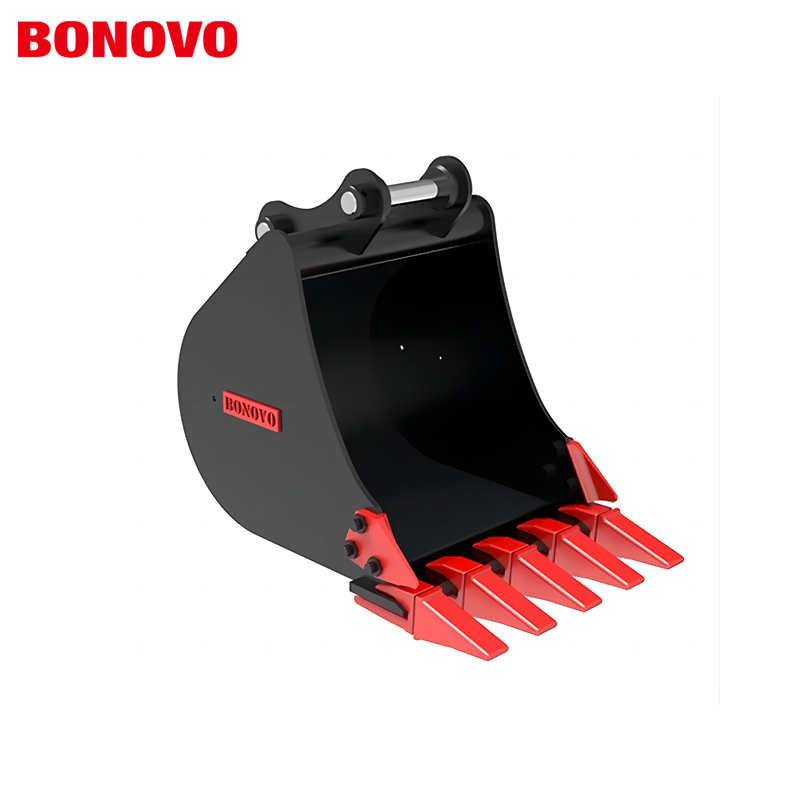
In the high-intensity operation of the excavator, the bucket teeth are key components that face various complex working conditions. The length of their service life is not only related to the operating efficiency, but also closely related to cost control. A large number of practices have shown that many factors jointly affect the durability of bucket teeth. The following is a detailed description of practical strategies to improve the service life of excavator bucket teeth.
Regularly change positions and balance wear
In actual operation, it is not difficult to find that the bucket teeth on the outside of the excavator bucket wear about 30% faster than the inside. This is because the impact and friction forces on the outside of the bucket are more concentrated during the excavation process. In view of this, it is recommended to swap the inside and outside positions of the bucket teeth after a period of use. In this way, the wear degree of the bucket teeth can be effectively balanced and its overall service life can be significantly extended.
Select teeth according to the situation and adapt to the working conditions
The selection of bucket teeth needs to be flexibly adjusted according to the specific working environment. Generally speaking, when excavating relatively soft materials such as earthwork, weathered sand, and coal, flat-head bucket teeth are an ideal choice. Due to its design characteristics, it can operate efficiently under such working conditions. When facing blocky hard rocks, RC bucket teeth can better cope with strong impact and friction with their unique structure and material. For the excavation of blocky coal seams, TL bucket teeth show unique advantages, which can not only effectively grab coal, but also improve the coal block rate. However, in actual applications, many users tend to use universal RC bucket teeth. But it should be noted that, unless it is a special working condition, it is recommended to give priority to flat-head bucket teeth. This is because after a period of use, the front end of the RC bucket teeth will wear out, making it look like a "fist", thereby increasing the excavation resistance and causing power waste. In contrast, the flat-head bucket teeth can always maintain a relatively sharp working surface throughout the wear process, effectively reducing the excavation resistance and achieving fuel saving.
Standardized operation, fine driving
The operating method of the excavator driver has a profound impact on the service life of the bucket teeth. When lifting the boom, the driver should try to avoid retracting the bucket at the same time. If the boom is lifted while the bucket is retracted, the bucket teeth will be subjected to upward traction and are easily torn from the top, causing damage to the bucket teeth. Therefore, the coordination of actions is crucial during this operation. In addition, some drivers use too much force when operating the arm and arm movements, often "knocking" the bucket against the rock quickly or throwing it hard on the rock. This improper operation not only easily breaks the bucket teeth, but also may cause cracks on the bucket and even damage the large and small arms. Therefore, the driver must standardize the operation to reduce the damage to the bucket teeth.
Pay attention to the tooth seat and replace it in time
The wear condition of the tooth seat should not be ignored either, as it plays a key role in the service life of the bucket teeth. When the wear of the tooth seat reaches 10% - 15%, it is recommended to replace it in time. Because there will be a large gap between the excessively worn tooth seat and the bucket teeth, this will change the matching mode and stress point of the bucket teeth and the tooth seat. Due to the change of the stress point, the bucket teeth are subjected to uneven stress distribution during the operation, and are very likely to break.
Control the angle and dig reasonably
During the operation, the excavator driver also needs to accurately control the digging angle. When digging, the bucket teeth should be kept perpendicular to the working surface as much as possible, or the outward inclination angle should be no greater than 120 degrees. If the inclination angle is too large, the bucket teeth are easily broken due to uneven force. At the same time, avoid swinging the digging arm left and right under the condition of large resistance. Since the mechanical design of most types of bucket teeth does not fully consider the force in the left and right directions, this operation will cause the bucket teeth and tooth seats to bear excessive lateral force, eventually leading to breakage.
keywords:Mini crawler excavator,Mini crawler excavator attachments,Excavator attachments,Crawler excavator,Mini excavator purchase
Choose BONOVO for high-quality, customizable brush cutters for skid steers with fast delivery. Contact us today to discover how our superior products can enhance your land management tasks!

 Hot News
Hot News2024-09-18
2024-09-18
2024-07-03
2024-03-08
2024-03-08
2024-03-08